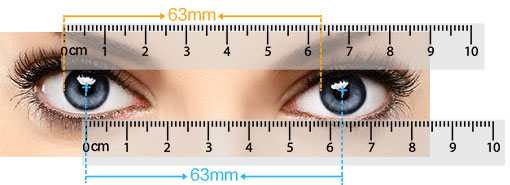- GlassesShop By FrameShop By StyleFeatured












Pupillary distance generally refers to the distance between the pupils when a person looks at things normally. This parameter needs to be considered when matching prescription glasses. That is, the distance between the centers of the two lenses should match your pupillary distance. The average adult’s PD is between 54-74 mm; kids' are between 43-58 mm.

If you don’t have your PD from your eye doctor, you can measure it yourself with our step-by-step guide below.
Step 1: Stand about 8 inch away from a mirror, hold your ruler in one hand. Look straight ahead into the mirror and position the ruler up against your eyebrows.
Step 2: Starting with the right eye, Close your right eye, then line up the ruler so that 0mm is in the middle your left pupil.
Step 3: Look straight ahead again and then open your right eye and close your left eye.
Step 4: Read the mm line that lines up with the centre of your right pupil, this measurement is your PD. Measure your PD 3-4 times at least to ensure it's accurate.
If a friend is measuring your PD, face your friend and keep both eyes open. Then have your friend put the 0mm on the millimeter ruler over the center of one pupil, then measure the distance to the center of the other pupil. That’s your PD. Do a couple tries to make sure the measurement is right.
Once you've got your PD measurement, fill in the prescription information in your cart and start shopping for glasses that fit you.
Every set of prescription lenses has an “optical center,” which is determined by pupillary distance. Pupillary distance is used to determine where you look through the lens of your glasses and should be as accurate as possible.
Single PD is the pupillary distance between the center of one pupil to the other, which can be a distance PD or near PD. Distance PD can be used to order any type of prescription glasses except reading glasses. Read below to learn how to calculate near PD for reading glasses.Dual PD, or monocular PD, consists of two numbers and is the distance between the centers of each pupil to the bridge of the nose. Dual PD is usually written in the following notation: 32/30. The first number is always the right eye (OD) measurement, and the second number is the left eye (OS).

You can calculate Near PD for reading glasses by subtracting 3mm from your distance PD. For example, if your distance PD is 63mm, then your near PD is 60mm.
If you are using Dual PD to calculate near PD, then subtract 1.5mm from each eye’s measurement. For example, if your dual PD is 33/31mm then your near PD would be 31.5/29.5mm.
How to read your eye prescription? sph, cyl, axis included
Measuring Clarity- All You Need to Know About Pupillary Distance (PD)
How to measure your pupillary distance (PD)
what is cyl in eye prescription?

